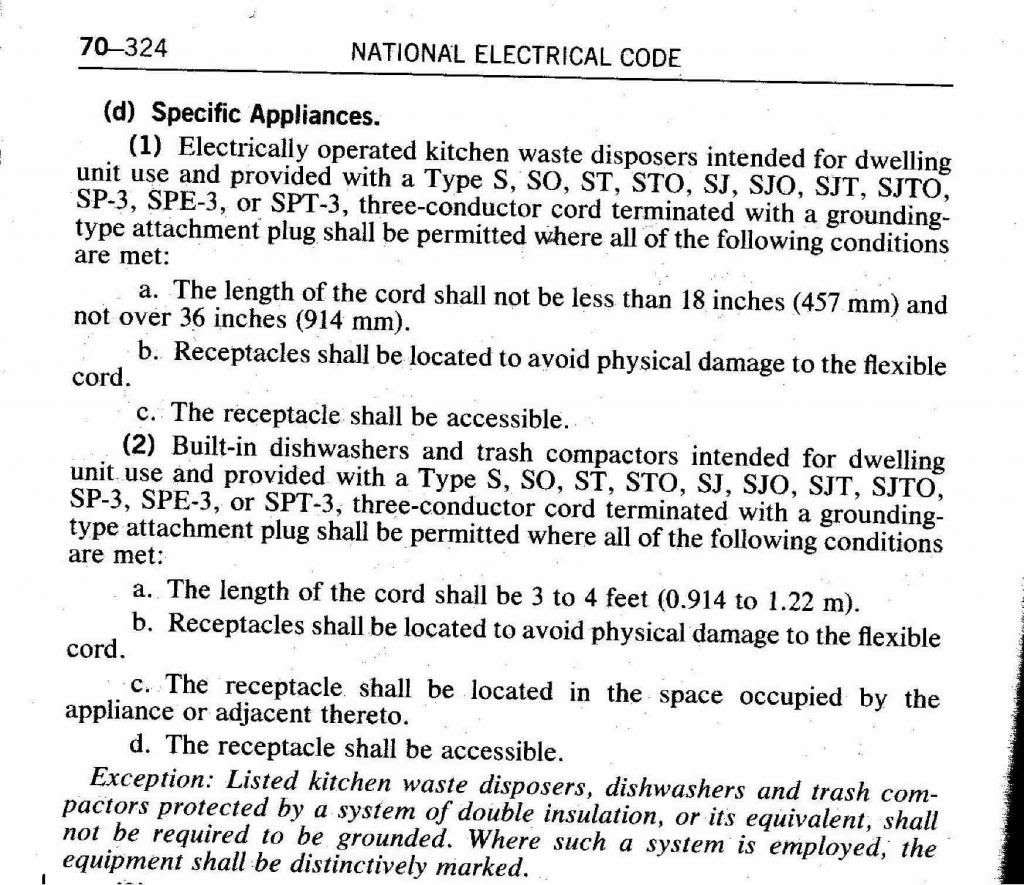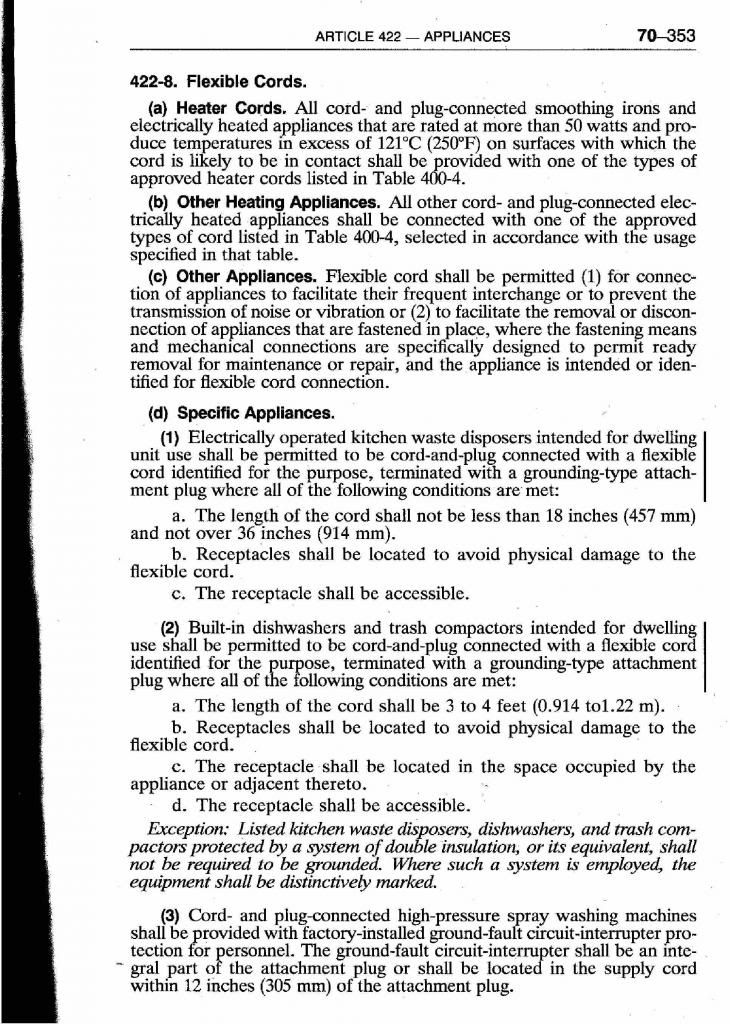Here is what it said in 1987 NEC:

Here is what it said in 1993 NEC:

I don't have 1990 NEC but I think it was similar to 1987 wording.
1996 wording is similar to 1993 wording.
For some reason I can't find my 1999 NEC so I don't know what is in there.
2002 wording is similar to what is in 2011 and is likely similar in those between.
So we have gone from NEC telling us what kind of cord is acceptable to the manufacturer telling us what cord is acceptable, and just like the classified breaker issue, why would the manufacturer suggest anything but what they sell? There is a good chance many manufacturers all have their acceptable cords made at the same place to the same specifications, only difference is the name on the packaging.:happysad:
1990 is when the listing of the type of cord that could be used, SE,SEO,SO, etc. under 428-8(d)(1)
1992
422.16 Flexible Cords.
(A) General. Flexible cord shall be permitted (1) for the connection of appliances to facilitate their frequent interchange or to prevent the transmission of noise or vibration or (2) to facilitate the removal or disconnection of appliances that are fastened in place, where the fastening means and mechanical connections are specifically designed to permit ready removal for maintenance or repair and the appliance is intended or identified for flexible cord connection.
(B) Specific Appliances.
(1) Electrically Operated Kitchen Waste Disposers. Electrically operated kitchen waste disposers shall be permitted to be cord-and-plug connected with a flexible cord identified as suitable for the purpose in the installation instructions of the appliance manufacturer, where all of the following conditions are met.
(1) The flexible cord shall be terminated with a grounding type attachment plug.
Exception: A listed kitchen waste disposer distinctly marked to identify it as protected by a system of double insulation, or its equivalent, shall not be required to be terminated with a grounding-type attachment plug.
(2) The length of the cord shall not be less than 450 mm (18 in.) and not over 900 mm (36 in.).
(3) Receptacles shall be located to avoid physical damage to the flexible cord.
(4) The receptacle shall be accessible.
(2) Built-in Dishwashers and Trash Compactors. Built-in dishwashers and trash compactors shall be permitted to be cord-and-plug connected with a flexible cord identified as suitable for the purpose in the installation instructions of the appliance manufacturer where all of the following conditions are met.
(1) The flexible cord shall be terminated with a grounding-type attachment plug.
Exception: A listed dishwasher or trash compactor distinctly marked to identify it as protected by a system of double insulation, or its equivalent, shall not be required to be terminated with a grounding-type attachment plug.
(2) The length of the cord shall be 0.9 m to 1.2 m (3 ft to 4 ft) measured from the face of the attachment plug to the plane of the rear of the appliance.
(3) Receptacles shall be located to avoid physical damage to the flexible cord.
(4) The receptacle shall be located in the space occupied by the appliance or adjacent thereto.
(5) The receptacle shall be accessible.
(3) Wall-Mounted Ovens and Counter-Mounted Cooking Units. Wall-mounted ovens and counter-mounted cooking units complete with provisions for mounting and for making electrical connections shall be permitted to be permanently connected or, only for ease in servicing or for installation, cord-and-plug connected.
A separable connector or a plug and receptacle combination in the supply line to an oven or cooking unit shall be approved for the temperature of the space in which it is located.
Range hoods added to cord and plug for 2005
2008
422.16 Flexible Cords.
(A) General. Flexible cord shall be permitted (1) for the connection of appliances to facilitate their frequent interchange or to prevent the transmission of noise or vibration or (2) to facilitate the removal or disconnection of appliances that are fastened in place, where the fastening means and mechanical connections are specifically designed to permit ready removal for maintenance or repair and the appliance is intended or identified for flexible cord connection.
It should be understood that a cord-connected appliance is required to be specifically designed, mechanically and electrically, to be readily removable for maintenance and repair.
(B) Specific Appliances.
(1) Electrically Operated Kitchen Waste Disposers. Electrically operated kitchen waste disposers shall be permitted to be cord-and-plug-connected with a flexible cord identified as suitable for the purpose in the installation instructions of the appliance manufacturer, where all of the following conditions are met:
(1)
The flexible cord shall be terminated with a grounding-type attachment plug.
Exception: A listed kitchen waste disposer distinctly marked to identify it as protected by a system of double insulation, or its equivalent, shall not be required to be terminated with a grounding-type attachment plug.
(2)
The length of the cord shall not be less than 450 mm (18 in.) and not over 900 mm (36 in.).
(3)
Receptacles shall be located to avoid physical damage to the flexible cord.
(4)
The receptacle shall be accessible.



